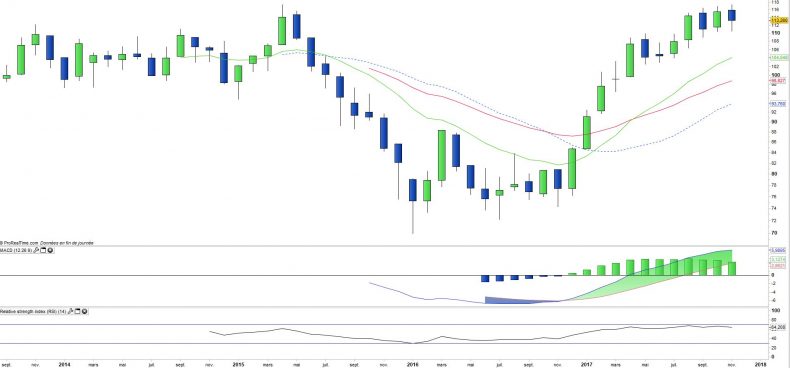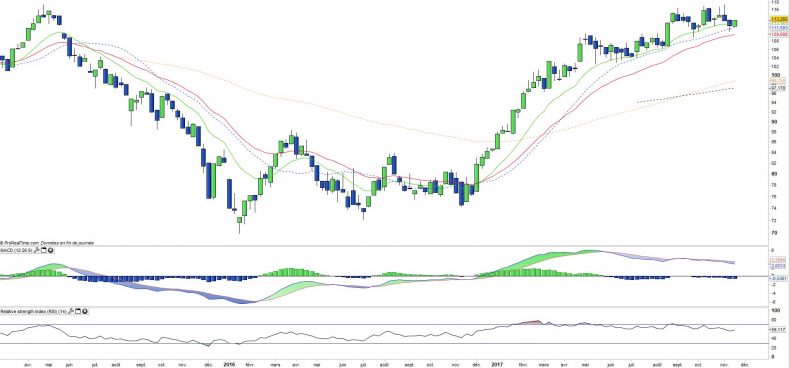Lyxor WIG 20 (WIG) - 21/11/2017
Short Term strategy : Neutral (50%) / Trend =
Long Term strategy : Positive (95%) / Trend =
Characteristics of the ETF
The WIG ETF (Lyxor) replicates the WSE WIG20 index of the 20 main Polish stocks selected according to their market capitalization and listed on the Warsaw Stock Exchange. This index embeds a risk linked to the evolution of the Euro / Zloti pair linked to the economy and the policy of the central banks of the two zones as well as to Europe-Russia relations.
The fees of this ETF are 0.45% for AUM of € 37 million. The replication method is indirect (via a swap) and there is a dividend capitalization policy.
Alternative ETFs: EPOL (Ishares in USD)
Index & components
This is a fairly narrow index and highly dependent on the financial sector (47% of capitalization) and energy (22%), followed by the consumer goods (11%) and commodities (9%) sector.
The top 10 stocks, where there are many banks and some industrial stocks represent 80% of the capitalization of the index and the top 3 values 42%, including PKO Bank (15.6%), refiner PKN Orlen (15.3%) ), and the insurer PZU (11.8%).
This tracker embeds the zloty risk, which can be influenced by external factors (such as relations with Russia). Poland has grown dramatically over the last 25 years and has become an important player in the European Union. Economic growth reached + 2.8% in 2016, supported by solid growth in investment and consumption. A member of the European Union since 2004, Poland was the only country in the EU to maintain positive growth during the financial crisis, GDP reached $ 509 billion in 2016 (23rd in the world). Russia's actions against Ukraine since the beginning of 2014 have put the issue of security on the political agenda.
Internal reforms will be needed to enable the country to benefit fully from the financial transfers from the European Union. In Poland, agriculture employs 11% of the active population and contributes 3.4% of GDP, the country is relatively rich in natural resources and the main minerals produced are coal, sulfur, copper, lead and iron, zinc. Manufacturing accounts for almost 33% of GDP, while the service sector accounts for about 64% of GDP. The traditional industrial sectors of iron and steel and shipbuilding are in decline. The country's main industrial sectors are machinery manufacturing, telecommunications, environment, transportation, construction, industrial food preparation and information technology. The expanding service sector includes financial services, logistics, hospitality, utilities and informatics. Poland is a country open to foreign trade, which accounts for the bulk of GDP.
The geographical location of Poland gives it strategic importance. Indeed, it is located halfway between Paris and Moscow and between Stockholm and Budapest and has important ports that are connected to the North Sea thanks to the Baltic Sea. In addition, the country is a favorable place for the export of goods to the former Soviet republics. Since Poland's accession to the European Union, its exports have increased by more than 30%, especially to Russia. Structurally deficient, Poland's trade balance has tended to improve since 2012, as the recovery in exports is coupled with weak domestic demand. Since the first half of 2015, Poland's trade balance has turned positive, with exports growing faster than imports. Since the crisis in the euro area, the CIS countries and China are growing destinations for Polish exports. The three main trading partners of the country are Germany, England and the Czech Republic. The growth outlook for Poland is excellent for 2017 at 3.6%.
Latest developments
WIG has increased by 33.7% since the beginning of the year (against + 8.9% for the STOXX600NR), which corresponds to the catch-up of 2015 (-16.5%) and relative stability in 2016 (+ 3%).
The index has been stable since the summer and did not benefit from the September rally, which corresponds to the consolidation of the main refiners (PKN Orlen and Gruppa Lotos) in a context of a rebound in crude oil prices, while 10 years rates decreased at around 3.4%, which is not a favorable factor for banks.
The authoritarian excesses of the government currently in place remain a problem, but Europe has considerable leverage by linking the granting of cohesion funds, of which Poland is the main beneficiary (€ 86bn over the period 2014-2020) with respect for the rule of law, which could be activated soon. Poland's Gross Domestic Product (GDP) grew by 1.1% in the third quarter of 2017, which represents an annual increase of 5.0% in the third quarter, above expectations, compared to + 4.4% in second trimester.
The growth forecast for 2017 is confirmed at 3.6% while in 2016, Poland had posted a GDP growth of 2.7%, after an increase of 3.6% in 2015 and 3.3% in 2014. The valuation multiples of the WIG20 index are reasonable (PER of 15x 2017 earnings), especially in relation to the growth rate. However, it is explained by the importance of the financial sector, which is generally applied with lower multiples than those of the global index.
Monthly data
The analysis of the monthly charts shows a trend that is once again bullish since the first quarter of 2017. However, a lateral consolidation is under way just below the historical resistance of € 117. The resistance is worked seriously and should eventually yield soon. The oscillators are positives and the initial overbought state has disappeared.
WIG now seems ready for a new upward momentum and the achievement of new historical highs.
Weekly data
Weekly chart analysis shows some flattening of the uptrend, which is spreading to moving averages. The oscillators have turned down but remain in the high zone. This flat correction seems to be coming to an end and should lead to a more directional phase in the coming weeks. Particular attention will be paid to the breakout of the € 117, and conversely a possible downward breakout of the M26E.
ETF Objective
WIG is a UCITS compliant ETF that aims to track the benchmark index WSE WIG20 (Poland - 20 companies).
Characteristics
| Inception date | 19/08/2013 |
| Issuer | Lyxor |
| Expense ratio | 0,45% |
| Benchmark | WSE WIG20 |
| Ticker / code | WIG |
| Currency | € |
| Exchange | Euronext |
| Assets Under Management | 39 M€ |
| Replication method | Indirect (swap) |
| Dividend | Capitalization |
| PEA (France) | No |
| SRD (France) | No |
| Currency risk | Yes (€/Zloty) |
| Number of Holdings | 20 |
| Risk | 4/5 |
Country breakdown
| Poland | 100% |
Sector Breakdown
| Financials | 47% |
| Energy | 23% |
| Consumer discretionary | 10% |
| Materials | 9% |
| Utilities | 7% |
| Information Technology | 2% |
| Telecom Services | 2% |
| Others | 1% |
Top Ten Holdings
| Polski Koncern Naftowy | 16% |
| PKO Bank Polski | 16% |
| Powszechny Zaklad U. | 12% |
| Bank Pekao | 9% |
| KGHM Polska Miedz | 7% |
| Bank Zachodni WBK | 5% |
| LPP | 5% |
| Polskie Gornictwo Naftowe | 4% |
| PGE | 4% |
| CCC | 3% |


